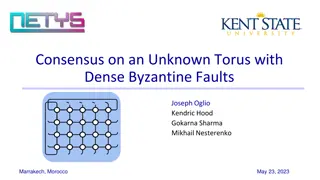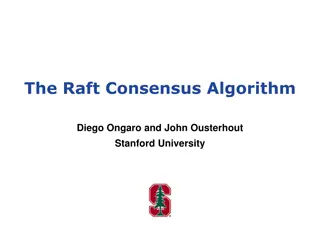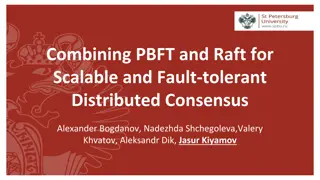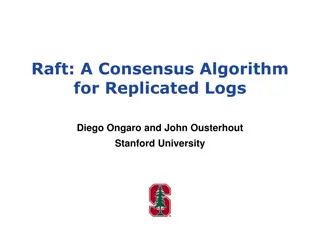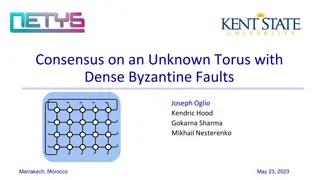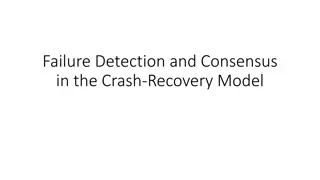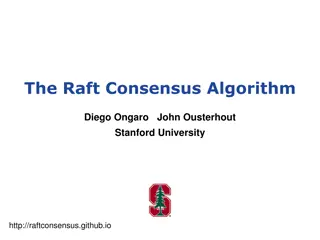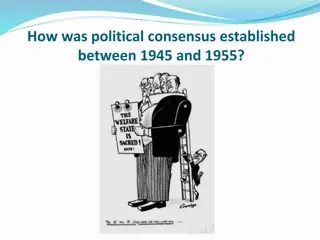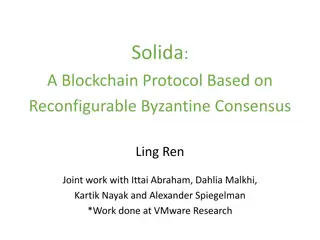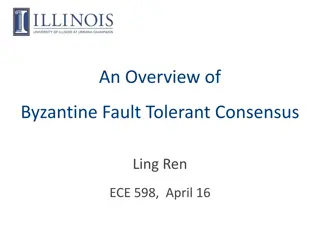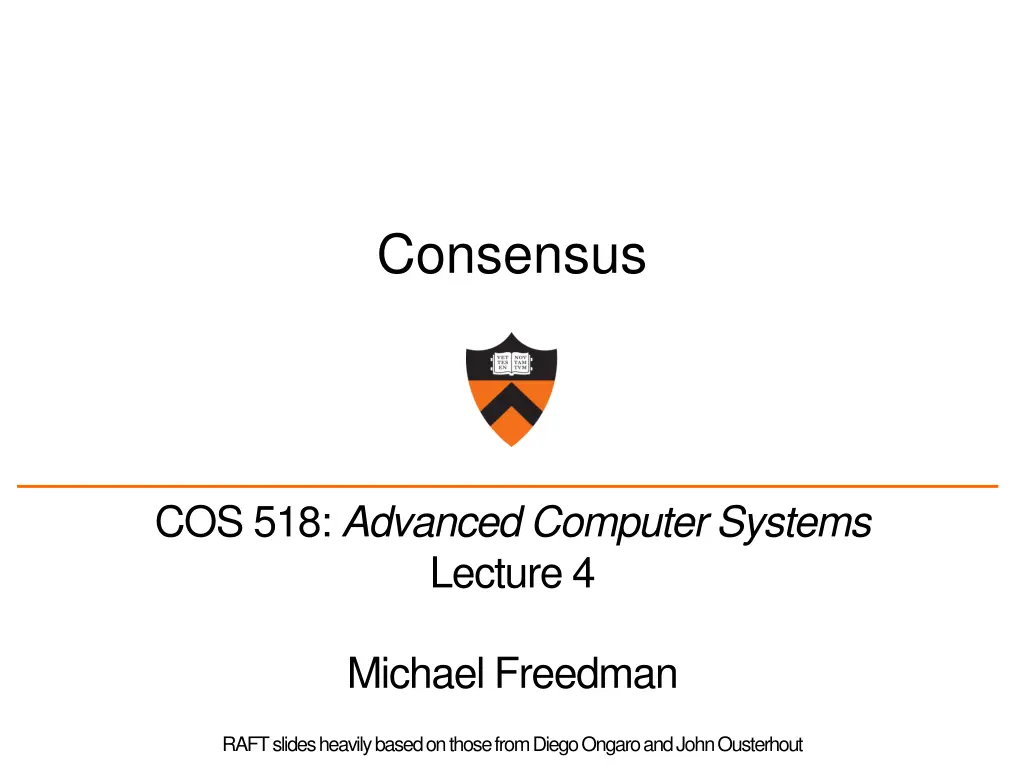
Understanding Consensus in Advanced Computer Systems
Dive into the world of advanced computer systems with a focus on consensus protocols like linearizability, two-phase commit, and Paxos. Explore concepts such as strong consistency, two-phase commit protocol, and the role of consensus in maintaining system integrity and resource access. Learn about the importance of mutual agreement and decision-making in distributed systems.
Uploaded on | 1 Views
Download Presentation

Please find below an Image/Link to download the presentation.
The content on the website is provided AS IS for your information and personal use only. It may not be sold, licensed, or shared on other websites without obtaining consent from the author. If you encounter any issues during the download, it is possible that the publisher has removed the file from their server.
You are allowed to download the files provided on this website for personal or commercial use, subject to the condition that they are used lawfully. All files are the property of their respective owners.
The content on the website is provided AS IS for your information and personal use only. It may not be sold, licensed, or shared on other websites without obtaining consent from the author.
E N D
Presentation Transcript
Consensus COS 518: Advanced Computer Systems Lecture 4 Michael Freedman RAFT slides heavily based on those from Diego Ongaro and John Ousterhout
Recall: Linearizability (Strong Consistency) Provide behavior of a single copy of object: Read should return the most recent write Subsequent reads should return same value, until next write Telephone intuition: 1. Alice updates Facebook post 2. Alice calls Bob on phone: Check my Facebook post! 3. Bob reads Alice s wall, sees her post 2
Two phase commit protocol 1. C P: request <op> Client C 2. P A, B: prepare <op> A, B P: prepared or error 3. Primary P 4. P C: result exec<op> or failed 5. P A, B: commit<op> What if primary fails? Backup fails? Backup A B 3
Two phase commit protocol 1. C P: request <op> Client C 2. P A, B: prepare <op> A, B P: prepared or error 3. Primary P 4. P C: result exec<op> or failed 5. P A, B: commit<op> Okay (i.e., op is stable) if written to > nodes Backup A B 4
Two phase commit protocol Client C > nodes > nodes Primary P Commit sets always overlap 1 Any > nodes guaranteed to see committed op Backup A B provided set of nodes consistent 5
Consensus Definition: 1. A general agreement about something 2. An idea or opinion that is shared by all the people in a group Origin: Latin, from consentire 6
Consensus used in systems Group of servers attempting: Make sure all servers in group receive the same updates in the same order as each other Maintain own lists (views) on who is a current member of the group, and update lists when somebody leaves/fails Elect a leader in group, and inform everybody Ensure mutually exclusive (one process at a time only) access to a critical resource like a file 7
Paxos: the original consensus protocol Safety Only a single value is chosen Only a proposed value can be chosen Only chosen values are learned by processes Liveness *** Some proposed value eventually chosen if fewer than half of processes fail If value is chosen, a process eventually learns it 8
Basic fault-tolerant Replicated State Machine (RSM) approach 1. Consensus protocol to elect leader 2. 2PC to replicate operations from leader 3. All replicas execute ops once committed 9
Why bother with a leader? Not necessary, but Decomposition: normal operation vs. leader changes Simplifies normal operation (no conflicts) More efficient than leader-less approaches Obvious place to handle non-determinism 10
Raft: A Consensus Algorithm for Replicated Logs Diego Ongaro and John Ousterhout Stanford University 11
Goal: Replicated Log Clients shl Consensus Module State Machine Consensus Module State Machine Consensus Module State Machine Servers Log Log Log add jmp mov shl add jmp mov shl add jmp mov shl Replicated log => replicated state machine All servers execute same commands in same order Consensus module ensures proper log replication 12
Raft Overview 1. Leader election 2. Normal operation (basic log replication) 3. Safety and consistency after leader changes 4. Neutralizing old leaders 5. Client interactions 6. Reconfiguration 13
Server States At any given time, each server is either: Leader: handles all client interactions, log replication Follower: completely passive Candidate: used to elect a new leader Normal operation: 1 leader, N-1 followers Follower Candidate Leader 14
Liveness Validation Servers start as followers Leaders send heartbeats (empty AppendEntries RPCs) to maintain authority If electionTimeout elapses with no RPCs (100-500ms), follower assumes leader has crashed and starts new election timeout, new election timeout, start election receive votes from majority of servers start Follower Candidate Leader step down discover server with higher term discover current leader or higher term 15
Terms (aka epochs) Term 1 Term 2 Term 3 Term 4 Term 5 time Elections Split Vote Normal Operation Time divided into terms Election (either failed or resulted in 1 leader) Normal operation under a single leader Each server maintains current term value Key role of terms: identify obsolete information 16
Elections Start election: Increment current term, change to candidate state, vote for self Send RequestVote to all other servers, retry until either: 1. Receive votes from majority of servers: Become leader Send AppendEntries heartbeats to all other servers 2. Receive RPC from valid leader: Return to follower state 3. No-one wins election (election timeout elapses): Increment term, start new election 17
Elections Safety: allow at most one winner per term Each server votes only once per term (persists on disk) Two different candidates can t get majorities in same term Voted for candidate A B can t also get majority Servers Liveness: some candidate must eventually win Each choose election timeouts randomly in [T, 2T] One usually initiates and wins election before others start Works well if T >> network RTT 18
Log Structure log index 1 2 1 3 1 ret 4 2 5 3 6 3 7 3 8 3 term 1 leader add cmp mov jmp div shl sub command 1 1 1 2 3 add cmp ret mov jmp 1 1 1 2 3 3 3 3 add cmp ret mov jmp div shl sub followers 1 1 add cmp 1 1 1 2 3 3 3 add cmp ret mov jmp div shl committed entries Log entry = < index, term, command > Log stored on stable storage (disk); survives crashes Entry committed if known to be stored on majority of servers Durable / stable, will eventually be executed by state machines 19
Normal operation shl Consensus Module State Machine Consensus Module State Machine Consensus Module State Machine Log Log Log add jmp mov shl add jmp mov shl add jmp mov shl Client sends command to leader Leader appends command to its log Leader sends AppendEntries RPCs to followers Once new entry committed: Leader passes command to its state machine, sends result to client Leader piggybacks commitment to followers in later AppendEntries Followers pass committed commands to their state machines 20
Normal operation shl Consensus Module State Machine Consensus Module State Machine Consensus Module State Machine Log Log Log add jmp mov shl add jmp mov shl add jmp mov shl Crashed / slow followers? Leader retries RPCs until they succeed Performance is optimal in common case: One successful RPC to any majority of servers 21
Log Operation: Highly Coherent 1 2 1 3 1 ret 4 2 5 3 6 3 1 server1 add cmp mov jmp div 1 1 1 2 3 4 server2 add cmp ret mov jmp sub If log entries on different server have same index and term: Store the same command Logs are identical in all preceding entries If given entry is committed, all preceding also committed 22
Log Operation: Consistency Check 1 2 3 4 5 1 1 1 2 3 leader AppendEntries succeeds: matching entry add cmp ret mov jmp 1 1 1 2 follower add cmp ret mov 1 1 1 2 3 leader add cmp ret mov jmp AppendEntries fails: mismatch 1 1 1 1 follower add cmp ret shl AppendEntries has <index,term> of entry preceding new ones Follower must contain matching entry; otherwise it rejects Implements an induction step, ensures coherency 23
Leader Changes New leader s log is truth, no special steps, start normal operation Will eventually make follower s logs identical to leader s Old leader may have left entries partially replicated Multiple crashes can leave many extraneous log entries 1 2 3 4 5 6 7 log index s1 1 1 5 6 6 6 term s2 1 1 5 6 7 7 7 s3 1 1 5 5 s4 1 1 2 4 s5 1 1 2 2 3 3 3 24
Challenge: Log Inconsistencies 1 2 3 4 5 6 7 8 9 10 11 12 Leader for term 8 1 1 1 4 4 5 5 6 6 6 (a) 1 1 1 4 4 5 5 6 6 Missing Entries (b) 1 1 1 4 (c) 1 1 1 4 4 5 5 6 6 6 6 Possible followers (d) 1 1 1 4 4 5 5 6 6 6 7 7 Extraneous Entries (e) 1 1 1 4 4 4 4 (f) 1 1 1 2 2 2 3 3 3 3 3 Leader changes can result in log inconsistencies 25
Repairing Follower Logs nextIndex 1 2 3 4 5 6 7 8 9 10 11 12 Leader for term 7 1 1 1 4 4 5 5 6 6 6 (a) 1 1 1 4 Followers (b) 1 1 1 2 2 2 3 3 3 3 3 New leader must make follower logs consistent with its own Delete extraneous entries Fill in missing entries Leader keeps nextIndex for each follower: Index of next log entry to send to that follower Initialized to (1 + leader s last index) If AppendEntries consistency check fails, decrement nextIndex, try again
Repairing Follower Logs 1 2 3 4 5 6 7 8 9 10 11 12 Leader for term 7 1 1 1 4 4 5 5 6 6 6 nextIndex Before repair (f) 1 1 1 2 2 2 3 3 3 3 3 (f) After repair 1 1 1 4
Safety Requirement Once log entry applied to a state machine, no other state machine must apply a different value for that log entry Raft safety property: If leader has decided log entry is committed, entry will be present in logs of all future leaders Why does this guarantee higher-level goal? 1. Leaders never overwrite entries in their logs 2. Only entries in leader s log can be committed 3. Entries must be committed before applying to state machine Committed Present in future leaders logs Restrictions on leader election Restrictions on commitment 28
Picking the Best Leader 1 2 3 4 5 Committed? s1 1 1 1 2 2 Can t tell which entries committed! s2 1 1 1 2 Unavailable during leader transition 1 1 1 2 2 Elect candidate most likely to contain all committed entries In RequestVote, candidates incl. index + term of last log entry Voter V denies vote if its log is more complete : pick log whose last entry has the higher term if last log term is the same, then pick longer log Leader will have most complete log among electing majority 29
Which one is more complete? 1 1 1 2 3 1 1 1 1 1 1 1 30
Which one is more complete? 1 1 1 2 3 1 1 1 2 3 3 3 31
Which one is more complete? 1 1 1 2 3 1 1 4 32
Committing Entry from Current Term 1 2 3 4 5 Leader for term 2 s1 1 1 2 2 2 s2 1 1 2 2 AppendEntries just succeeded s3 1 1 2 2 s4 1 1 2 Can t be elected as leader for term 3 s5 1 1 Case #1: Leader decides entry in current term is committed Safe: leader for term 3 must contain entry 4 33
Committing Entry from Earlier Term 1 2 3 4 5 Leader for term 4 s1 1 1 2 4 s2 1 1 2 AppendEntries just succeeded s3 1 1 2 s4 1 1 s5 1 1 3 3 3 Case #2: Leader trying to finish committing entry from earlier Entry 3 not safely committed: s5 can be elected as leader for term 5 If elected, it will overwrite entry 3 on s1, s2, and s3 34
Linearizable Reads? Not yet 5 nodes: A (leader), B, C, D, E A is partitioned from B, C, D, E B is elected as new leader, commits a bunch of ops But A still thinks he s the leader = can answer reads If a client contacts A, the client will get stale values! Fix: Ensure you can contact majority before serving reads by committing an extra log entry for each read This guarantees you are still the rightful leader
Monday lecture 1. Consensus papers 2. From single register consistency to multi-register transactions 36
Neutralizing Old Leaders Leader temporarily disconnected other servers elect new leader old leader reconnected old leader attempts to commit log entries Terms used to detect stale leaders (and candidates) Every RPC contains term of sender Sender s term < receiver: Receiver: Rejects RPC (via ACK which sender processes ) Receiver s term < sender: Receiver reverts to follower, updates term, processes RPC Election updates terms of majority of servers Deposed server cannot commit new log entries 38
Client Protocol Send commands to leader If leader unknown, contact any server, which redirects client to leader Leader only responds after command logged, committed, and executed by leader If request times out (e.g., leader crashes): Client reissues command to new leader (after possible redirect) Ensure exactly-once semantics even with leader failures E.g., Leader can execute command then crash before responding Client should embed unique ID in each command This client ID included in log entry Before accepting request, leader checks log for entry with same id 39
Configuration Changes View configuration: { leader, { members }, settings } Consensus must support changes to configuration Replace failed machine Change degree of replication Cannot switch directly from one config to another: conflicting majorities could arise Cold Server 1 Server 2 Server 3 Server 4 Server 5 Cnew Majority of Cold Majority of Cnew time 41
2-Phase Approach via Joint Consensus Joint consensus in intermediate phase: need majority of both old and new configurations for elections, commitment Configuration change just a log entry; applied immediately on receipt (committed or not) Once joint consensus is committed, begin replicating log entry for final configuration Cold can make unilateral decisions Cnew can make unilateral decisions Cnew Cold+new Cold Cold+new entry committed Cnew entry committed time 42
2-Phase Approach via Joint Consensus Any server from either configuration can serve as leader If leader not in Cnew, must step down once Cnew committed Cold can make unilateral decisions Cnew can make unilateral decisions Cnew Cold+new leader not in Cnew steps down here Cold Cold+new entry committed Cnew entry committed time 43
Viewstamped Replication: A new primary copy method to support highly- available distributed systems Oki and Liskov, PODC 1988 44
Raft vs. VR Strong leader Log entries flow only from leader to other servers Select leader from limited set so doesn t need to catch up Leader election Randomized timers to initiate elections Membership changes New joint consensus approach with overlapping majorities Cluster can operate normally during configuration changes 45
View changes on failure 1. Backups monitor primary 2. If a backup thinks primary failed, initiate View Change (leader election) Primary P Backup A B 46
View changes on failure 1. Backups monitor primary 2. If a backup thinks primary failed, initiate View Change (leader election) Requires 2f + 1 nodes to handle f failures 3. Inituitive safety argument: View change requires f+1 agreement Op committed once written to f+1 nodes At least one node both saw write and in new view Backup A Primary P 4. More advanced: Adding or removing nodes ( reconfiguration ) 47






